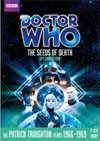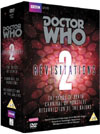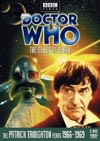DVD Extras include:
Padded Off StoryThe plot is actually quite good, all set to explore a variety of interesting scientific concepts and bring the Ice Warriors back for a more battle-oriented tooth-and-nail struggle to do justice to their name - all of which helped elevate this to be the season six Troughton story I anticipated I would enjoy the most before I actually first saw it. Unfortunately, there is about a full episode's worth of padding scattered throughout the entire script, and much of it strains the characters' credibility and becomes irritating. No, none of this forms any sort of character-arc or really tackles any issues. At the end of the day, the formula reveals itself for what it is: padding. A real bore for the audience.But padding aside, the real problem with "The Seeds of Death" is the fact that Michael Ferguson was not at his best, and his worst Doctor Who story here features some atrocious directing. Mind you, Ferguson does have my sympathies in trying to figure out how to keep such a padded story interesting, and to his credit he does apply thought to composing many of the shots and sequences artistically and cleverly, but those thoughts often had vaguely little to do with the telling of the story or with capturing the mood of the scene. They attempt to be clever on their own merit, while the story gets lost. Action is often blocked out in ways that are completely embarrassing, while the wrong bits of information are visually withheld. I first saw this one as the then-newly-released movie-length VHS video was shown at a convention, and it was extremely sad to see such a large number of die-hard fans practically falling asleep on their favourite program. I nearly nodded off myself!
"Beam me up, 'ss Kelly."Doctor Who's answer to Star Trek's transporter beam is introduced for the first time in this story, called Travel-Mat or T-Mat here, although later stories would slightly alter the name to Trans-Mat, short for Matter Transmission. Ferguson does a lame job of directing the whole of the first scene in T-Mat control, with cameras out of focus, or pointing at a person's legs instead of their faces, etc., but his all-too-obvious avoidance of a proper dissolve effect to introduce the much-used T-Mat idea in his story is pretty unforgivable, especially as the run-on recording of the early days of Doctor Who had given way to (relatively) advanced editing control and out-of-order recording. Even if corners must be cut, the most important place to keep a full effect intact is at the beginning when the process is introduced, and it is here that Ferguson does his worst to it, building the anticipation that future uses of the device will be equally cheap.Granted, the DVD has improved this effect enormously by realigning the jump-cuts and making sure that the transitions flow smoothly, which goes enormously far to help modern audiences enjoy the effect, such as it is. Still, we don't get the effect in many places where we would ideally still need it. The TARDIS makes an equally cheap entrance, while the ensuing dialogue plays off the assumption that the audience already knows about the Doctor and his mode of conveyance, and the travellers are once more needlessly enigmatic about explaining themselves, particularly as this society has learned to accept sudden materialization.
The Ice ZombiesThe Ice Warriors seem to be a greater source of cheapness than menace. Leader Slaar's voice is such a quiet whisper that about half of his lines were completely inaudible in the VHS version, and we had to guess what he had said from others' responses - thankfully this has all now been cleaned up for the DVD version, and Slaar is now completely understandable. The mirrorlon effect looks absolutely terrible this time around - instead of contracting an image towards the centre to give an impression of implosion, it usually just wobbles around in this story and makes it very difficult for the audience to know what in tarnation they are supposed to be looking at, much less who actually just got shot and killed. The effect only gets done justice in a couple of shots in later episodes, often on location.Revealing the Ice Warriors visually also reveals the poor coordination between acting and directing. The Ice Warriors display such a lack of menace that it is more appropriate to call them Ice Zombies. Poor shot planning and sequencing makes the Ice Zombies look incredibly slow-witted and incompetent, while their opposition fares little better. One thing that does work well here, particularly in bringing back some menace to the Ice Warriors, is Dudley Simpson's music. As with the previous Ice Warrior adventure, we get creative instrument sounds and a good deal of power and energy in the story's music. Additionally, the DVD restoration team has brought the quality of the sound to a very high and enjoyable level. There are a few sections that still betray the program's age, but for the most part this is a really outstanding job, highlighting what has always traditionally been one of Doctor Who's great strengths: that of a very effective and atmospheric soundtrack. Indeed, had this adventure been lost, and our only assessment of it been through a surviving soundtrack, we would probably be ranking it as a highly suspenseful story.
Characters and ActingI have no direct complaints about Fewsham, as his character is rather well-fleshed out and Terry Scully plays it well, balancing accuracy with little mannerisms that keep Fewsham interesting. I'm not sure if it was wise to confine so much of the Ice Zombie menace to one particular dominant dynamic, which may not be rich enough to sustain audience interest over five and a half episodes.The Doctor and his friends involve themselves with the locals out of heroic impulse and in a timely fashion, however it is the guest characters who hoard the dialogue. Professor Eldred needs to delay the plot for a good 15 to 20 minutes to meet the story's timing requirements, and so even though his long-time theories have at last been proven right and the opportunities he's always wanted are presented to him on a silver platter, he digs his heel in and drags that plot, without any of his dialogue offering the frustrated audience any clue as to what might motivate this. Early episodes are full of minor characters who are neither scripted nor acted out in anything of an interesting fashion. Harry Towb's Osgood is one of the few that actually adds something worthwhile to the story, and it's too bad we didn't see more of his face in focus during his first scene. Radnor, Kelly, and Eldred are not badly constructed characters, it's just that their interpersonal conflicts are not motivated in a clear manner worthy of our interest. The actors do an exceptional job of playing them under the circumstances, and in the end I think this story has one of the best casts in all of season six. Although models of the Ice Zombies' spacecraft are notorious by their absence, the model work actually done in this story is of a refreshingly high calibre, particularly the Earth rocket that our three regulars pilot, as well as its take-off and landing ports on the ground and the moon. Some of the plot dynamics surrounding rockets and space travel get a bit overplayed when the audience can easily think of a perfectly good "Plan B", but the characters cannot. The Doctor finally gets some good bits after the adventure's slow start, but unfortunately, this good stuff is curtailed when Patrick Troughton to go off on holiday for one of the episodes. At least the companions and guest characters are kept in line and focused on all the right goals in Troughton's absence; it is chiefly the story padding that drags the Doctor-less episode down, which would still have been there with or without Troughton. The plot does make important moves here though, and there's one really good shot when the T-Mat jump cuts finally prove more effective than dissolves. Nice moment! A bit of location work adds an extra element of believability to the story. On the VHS version all that outdoor stuff somehow managed to seem terribly claustrophobic and thus not as enjoyable as it should be, but this feeling doesn't seem to affect the much crisper, cleaner DVD presentation.
Good Final Episodes"The Seeds of Death" finally manages to pick itself up and become half-way decent in the final two episodes. Episode five in particular keeps the Doctor extremely busy tackling most of the mysteries and problems of the tale. Most of the concluding action is reserved for episode six, however, and it is generally an improvement on what has gone before. The stakes are raised, and the good guys put their own cunning to great use. One of the more important new sound effects is a bit of a flop at this stage though.Many Doctor Who stories work well when the episodes are combined into one movie-length show, but "The Seeds of Death" is the epitome of a story that needs to be shown as separate episodes only. Its earlier sleepy pace badly needs to be broken up by the occasional burst of a popular theme song and cool opening graphics, while four or five of its most suspenseful moments can linger a bit longer in a viewer's memory. Doctor Who is particularly adept at turning these elements of a serialized program into one of its major strengths, a power which it just about doubled the following year for season seven, and the movie length version of "The Seeds of Death" on VHS does the story no favours by removing this asset of the program. The story here is probably not strong enough to justify double-dipping on the Special Edition DVD if you'd already bought the earlier DVD from 2003/2004. Me, I'd been waiting 8 years for the price to come down on the regular DVD before I stooped to buy it, since the VHS had so put me off of the story... and bizarrely, the price STILL hasn't come down on the original here in Canada. I don't know who's going to buy that now that the new edition is cheaper and comes with extra bells and whistles. So, I'm happy to skip it and go directly from VHS to the Special Edition DVD which I am enjoying. As for extras, I don't know why the featurette "Lords of the Red Planet" is listed everywhere as a history of the Ice Warriors. It is actually a making-of documentary focused on this one story "The Seeds of Death", and takes its title from a previous story idea that almost got made in place of this one. The TARDIS-Cam feature is also bizarrely labeled - both this one and the very different one on the DVD for "The Talons of Weng-Chiang" (story no. 91) are labeled as being number six. Well come on, that can't be right! "The Seeds of Death" originally came out first, so this one is probably no. 5 in reality. You'd think someone would have caught this before the Special Edition came out. The Special Edition has left out the previous DVD's featurettes "The Last Dalek" and the New Zealand Censor Clips.... and why not since they had nothing to do with this story and are repeated in the much more appropriate "Lost in Time" DVD sets.
This story has become available on DVD and VHS video. Click on the Amazon symbol for the location nearest you for pricing and availability.
Comments on this article are welcome. You may contact the author from this page:
|
|||||||||||||||||||||||||||||||||||










